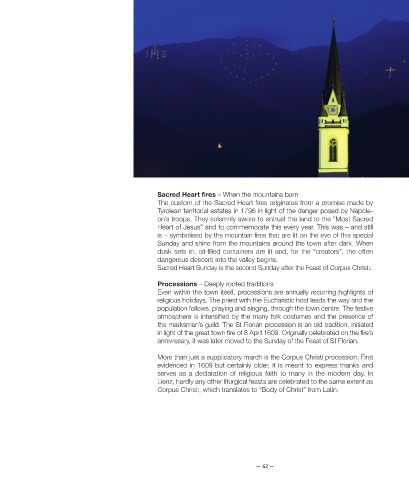Page 59 - Lienz Treasure Chest
P. 59
Sacred Heart fires – When the mountains burn Olala Street Theatre Festival – Laughter is colourful
The custom of the Sacred Heart fires originates from a promise made by With famous street artists, fun marches through the streets for a
Tyrolean territorial estates in 1796 in light of the danger posed by Napole- whole week in summer. The fireworks of international cabaret arts
on’s troops. They solemnly swore to entrust the land to the “Most Sacred leads thousands to Lienz every year. The programme covers the
Heart of Jesus” and to commemorate this every year. This was – and still whole gamut of modern street art: street shows, walking acts,
is – symbolised by the mountain fires that are lit on the eve of this special comedy, performance art, acrobatics, music and even large pub-
Sunday and shine from the mountains around the town after dark. When lic square stagings. The high quality of the artistic performances
dusk sets in, oil-filled containers are lit and, for the “creators”, the often and the great atmosphere of the town at the feet of the Dolomites
dangerous descent into the valley begins. have turned “Olala” into one of the largest festivals of its kind in
Sacred Heart Sunday is the second Sunday after the Feast of Corpus Christi. Central Europe.
Info: www.ummigummi.at or www.olala.at
Processions – Deeply rooted traditions
Even within the town itself, processions are annually recurring highlights of
religious holidays. The priest with the Eucharistic host leads the way and the
population follows, praying and singing, through the town centre. The festive
atmosphere is intensified by the many folk costumes and the presence of
the marksmen’s guild. The St Florian procession is an old tradition, initiated
in light of the great town fire of 8 April 1609. Originally celebrated on the fire’s
annivresary, it was later moved to the Sunday of the Feast of St Florian.
More than just a supplicatory march is the Corpus Christi procession. First
evidenced in 1609 but certainly older, it is meant to express thanks and
serves as a declaration of religious faith to many in the modern day. In
Lienz, hardly any other liturgical feasts are celebrated to the same extent as
Corpus Christi, which translates to “Body of Christ” from Latin.
— 62 — — 63 —

